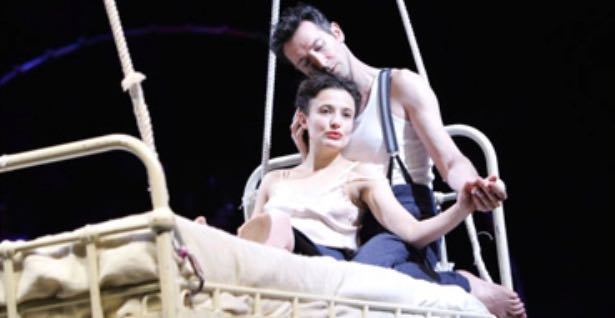By Ray Bennett
LONDON – Kneehigh Theatre’s highly energetic adaptation of the fondly recalled 1946 fantasy film “A Matter of Life and Death” at the National is staged cleverly and it is quite entertaining, but for fans of the movie it is an opportunity missed.
The film – written, produced and directed by Michael Powell and Emeric Pressburger – stars David Niven at his most charming as a British World War II bomber pilot who jumps from his burning plane without a parachute but does not die. An inept functionary for the afterlife has messed up, and the airman’s failure to report to heaven as expected upsets the strict order of these things.
The flyer has fallen in love with a woman from base command who was trying to get him home, and now he really doesn’t want to leave this mortal coil. The picture then follows twin paths as a celestial court debates his appeal of the death sentence that insists his time is up, while on Earth a surgeon attempts to heal his damaged brain.
The play follows the first part of the film using considerable invention to stage the plane crash, with Squadron Leader Peter Carter (Tristan Sturrock) at the top of a large metallic frame that later will double as the stairway to heaven that is a key image from the film. Below him, June (Lyndsey Marshal, pictured with Sturrock) does her best to guide his plane to safety, but the bluff Carter flirts with her in the face of death.
The stage is made busy with lots of people rushing about and a group of nurses lying on their backs on hospital beds pedalling bicycles in the air. It sounds strange, but with flashing lights and explosive sounds it gives a vivid impression of chaos.
Meanwhile, Conductor 71, who was supposed to deliver Carter to his fate, is instructed to return to Earth to complete his mission. In the film, this character is a fey Frenchman. Here, it’s an acrobatic Norwegian goofball played by Gisli Orn Gardarsson as perhaps a distant relative of Borat.
Douglas Hodge has the Roger Livesey role of Frank, the stalwart doctor who sees that Carter’s insistence on appealing his sentence means that brain surgery is essential. There are attempts with various degrees of success to re-create scenes from the film, including a camera obscura sequence, a pingpong match between June and Frank and the doctor’s death in a motorcycle crash.
There’s also a jazz combo on a movable platform onstage with a singer who belts out ballads and high-tempo numbers according to the mood. But in the film, the climactic court sequence turns into a riveting debate about the relative merits of Britain and the U.S.
The play has Carter prosecuted by William Shakespeare, his own late father and assorted victims of the World War II bombings of Coventry and Dresden who assail him for being a war criminal.
Those voices shouldn’t be forgotten, but given the current state of the world and the role Tony Blair’s government has played in legitimising some of the decisions of the Bush administration, an update of the original debate would have been more challenging. Not only that, but whereas in the film love wins, the play’s philosophy is that fate is nothing more than the toss of a coin, which might be closer to the truth but is a lot less inspiring.
Presented by the National Theatre in association with Kneehigh Theatre; Runs through June 21 2007; Cast: Tristan Sturrock, Lyndsey Marshal, Craig Johnson, Debbie Korley, Douglas Hodge, Andy Williams, Chike Okonkwo, Mike Shepherd; Based on the film by: Michael Powell and Emeric Pressburger adapted by: Tom Morris and Emma Rice; Director: Emma Rice; Set designer: Bill Mitchell; Costume designer: Vicki Mortimer; Lighting designer: Mark Henderson; Choreographers: Debra Batton, Emma Rice; Music: Stu Barker; Sound designer: Gareth Fry.
My full review appeared in The Hollywood Reporter

